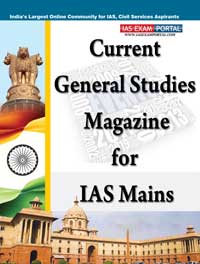(HOT) UPSC Current Affairs 2025 PDF
NEW! The Gist (NOV-2025) | E-BOOKS
Current General Studies Magazine: "Golden Rice isn’t Ready Yet" July 2016

Current General Studies Magazine (July 2016)
General Studies - III "Science & Technology Based Article" (Golden Rice isn’t Ready Yet)
Recently 110 Nobel Laureates issued a strongly worded plea to Greenpeace to “abandon their campaign against [genetically modified organisms] in general and Golden Rice in particular.” This is not the first time notable scientists have waded into the controversy surrounding genetically modified (GM) crops. What is remarkable about this latest foray, however, is their poor grasp of the facts surrounding Golden Rice.
Golden Rice is an orange-yellow-coloured rice, genetically modified to produce beta-carotene, the precursor of Vitamin A. Advocates claim it is a powerful way to combat Vitamin A deficiency, the cause of diseases like childhood blindness, and deaths, particularly among the poor in Africa, South and Southeast Asia. Golden Rice was first developed around 1999 by two European scientists, Ingo Potrykus and Peter Beyer. The transnational agribusiness corporation Syngenta currently holds commercial rights to it. Moved apparently by humanitarian sentiments, Syngenta decided in 2004 to sub-license it free of charge (subject to several conditions, not all of which are straightforward) to agricultural research institutions in developing countries, through an entity named the Golden Rice Humanitarian Board. The project of taking Golden Rice to developing countries is housed within the International Rice Research Institute (IRRI) in Philippines.
The Nobel Laureates argue that the reason this innovation has not started saving lives yet is Greenpeace’s criminal opposition. This narrative of conspiracy glosses over the rather more straightforward explanation: As IRRI itself admits on its website, Golden Rice is not ready for farmers, yet. There are above-board reasons for this which have little to do with anti-GM activists.
The Laureates say that Golden Rice has “ the potential to reduce or eliminate much of the death and disease caused by Vitamin A deficiency” (emphasis added). This statement begs the question: Under what conditions might that potential be actualised? At least two conditions need to be met for Golden Rice to work as hoped: it should be suitable for cultivation by farmers; and it should be bio-available, that is, the digestive system should be able to extract the beta-carotene and make it available to the body, thus improving Vitamin A levels. Questions remain on both counts.
Suitability for cultivation
The two versions of Golden Rice developed so far, Golden Rice 1 and 2, are both Japonica (sticky, dryland) rices, while people in areas with Vitamin A deficiency in South and Southeast Asia generally cultivate and consume the non-sticky, submerged Indica paddies. Japonica varieties are easier to modify genetically, but do not perform well in Asian fields. IRRI is still in the process of crossing Golden Rice into Indica varieties. In 2014, IRRI stated, “Results of the first round of multi-location trials of Golden Rice showed that… yields of candidate lines were not consistent across locations and seasons, prompting research direction toward assessing [other] Golden Rice versions.” This is hardly a rice ready for cultivation by farmers — it has not even entered the stage of biosafety evaluation by government regulatory institutions.
The question of bioavailability is even more vexed. The body does not necessarily absorb beta-carotene because one eats Golden Rice. The Golden Rice Humanitarian Board’s website quotes a study published in 2012 in The American Journal of Clinical Nutrition for establishing the effectiveness of Golden Rice. On July 29, 2015, the journal retracted this paper citing ethical concerns.
Even assuming that ethical concerns do not detract from the paper’s findings, the study design merits attention. The study saw middle-income, healthy Chinese children consuming a total of 210 grams of pork and other foods over breakfast and lunch daily, with 40 per cent of their total calorie intake coming from fat. Fats help the body absorb beta-carotene, since the latter dissolves easily in fats. Unlike customary practice, the Golden Rice fed to the children had been stored at minus 70{+o}C after drying for three days, to avoid any decline in beta-carotene levels with time. Thus, the study design favoured Golden Rice, rather than reflecting the actual lives and habits of poor Asians and Africans, who generally cannot afford fat-rich meals every day. So far, there is no answer to the real question: How will Golden Rice perform as part of meals that poor people, typically malnourished, actually eat?
The Nobel Laureates accuse Greenpeace’s campaign of raising the regulatory bar for GM crops. The facts above suggest that neither Greenpeace nor regulatory hurdles have delayed Golden Rice’s release. In fact, in 2009, the distinguished biotechnologist, Dr. Swapan Datta, former Deputy Director-General (Crop Science) of the Indian Council of Agricultural Research, who had worked on Golden Rice at IRRI, categorically stated, “The regulatory system is not the barrier to releasing Golden Rice in India.” IRRI itself, in its last update released in 2014, said: “Golden Rice will only be made available broadly to farmers and consumers if it is successfully developed into rice varieties suitable for Asia, approved by national regulators, and shown to improve Vitamin A status in community conditions.”
Let us, for the moment, ignore the political aspects of Golden Rice and GM crops. Let us overlook the fact that many sciences (other than physics, chemistry, and medicine represented in the letter) have something to contribute to the debate over GM crops — in India, agricultural scientists, ecologists, nutritionists, and sociologists, among others, have insightfully contributed to the debate. Let us instead ask two basic questions. Is Golden Rice ready to be cultivated by farmers? IRRI itself answers no. Does Golden Rice improve Vitamin A levels among people as they actually live and eat? We don’t know yet.

